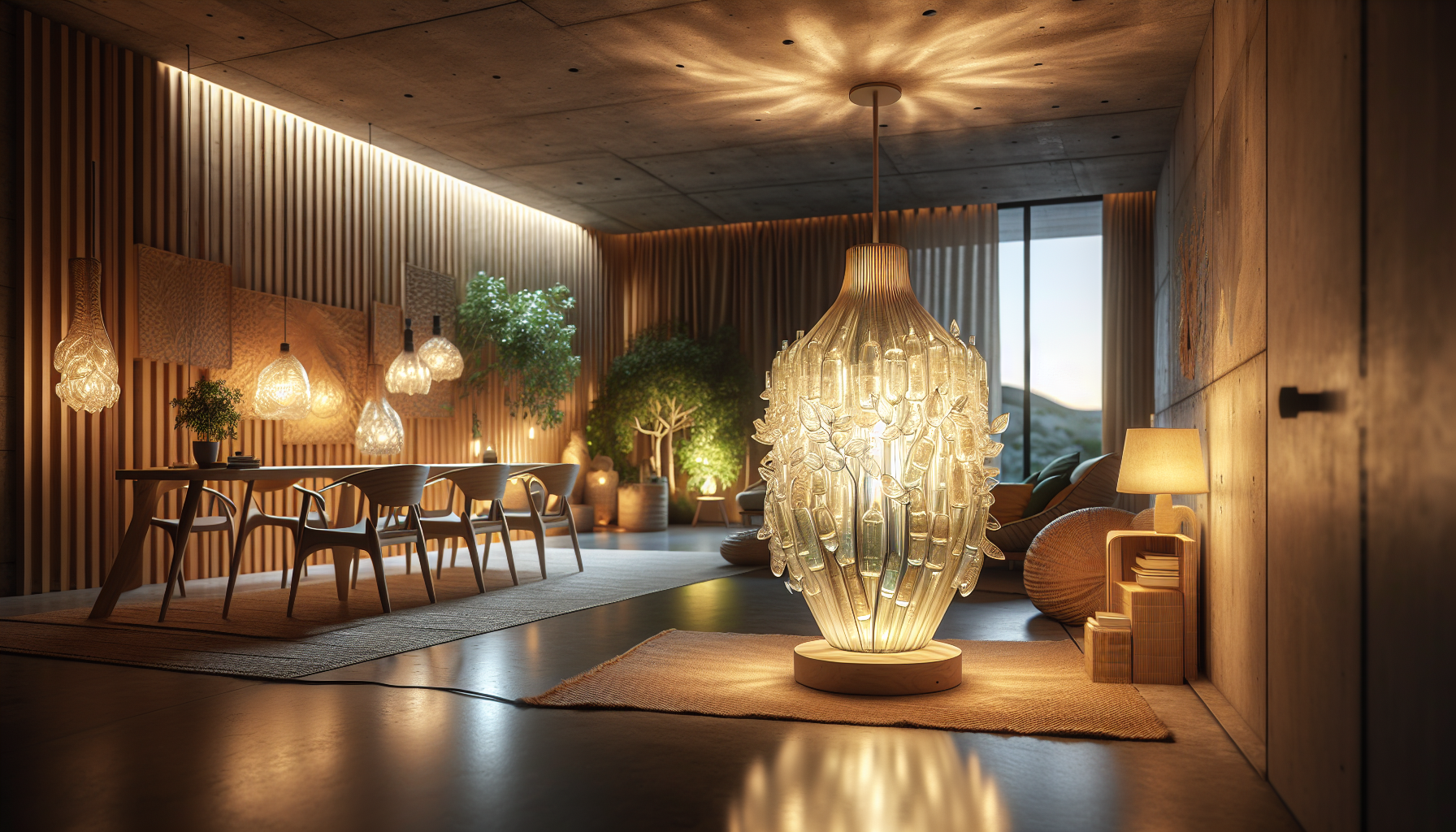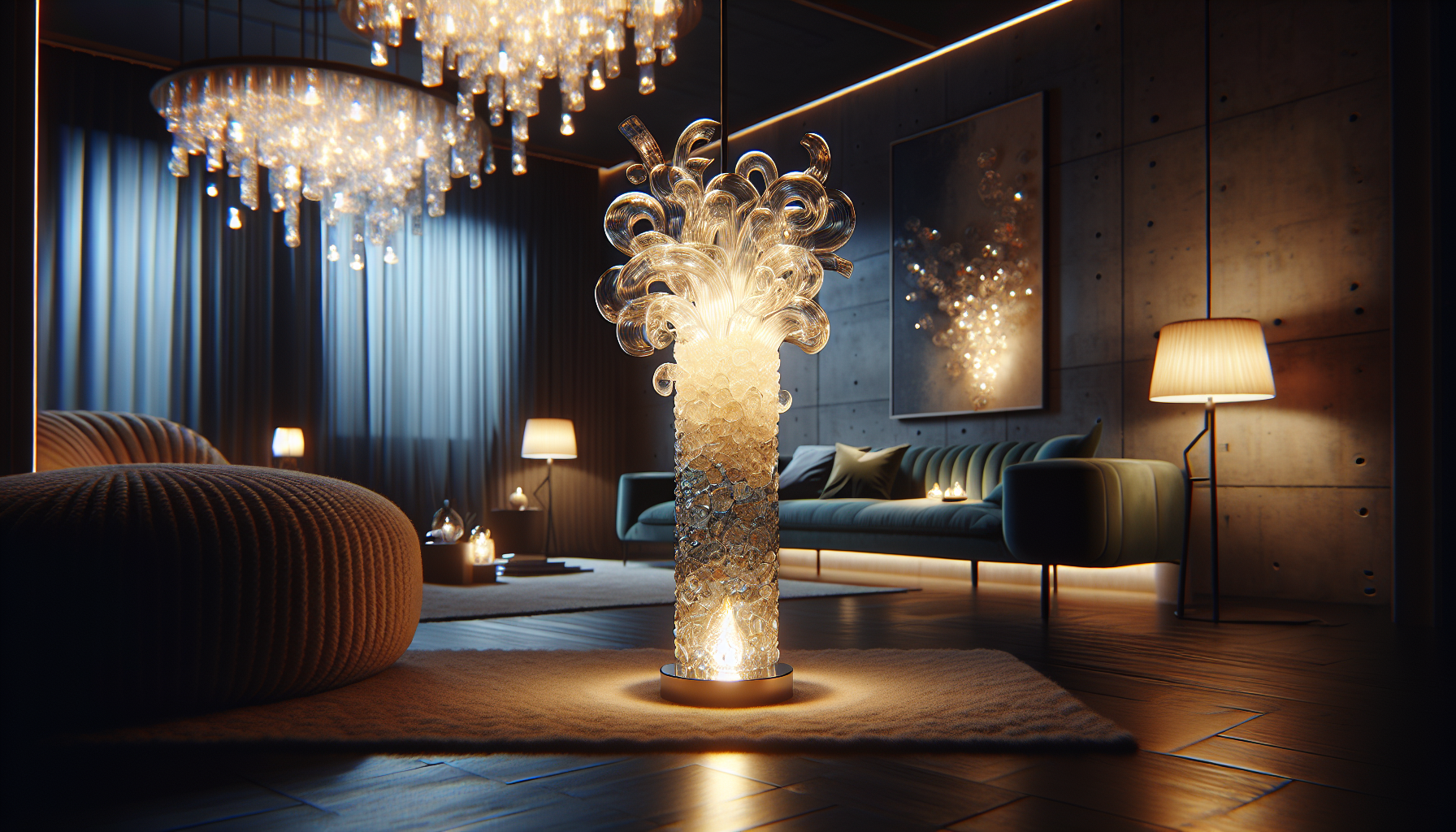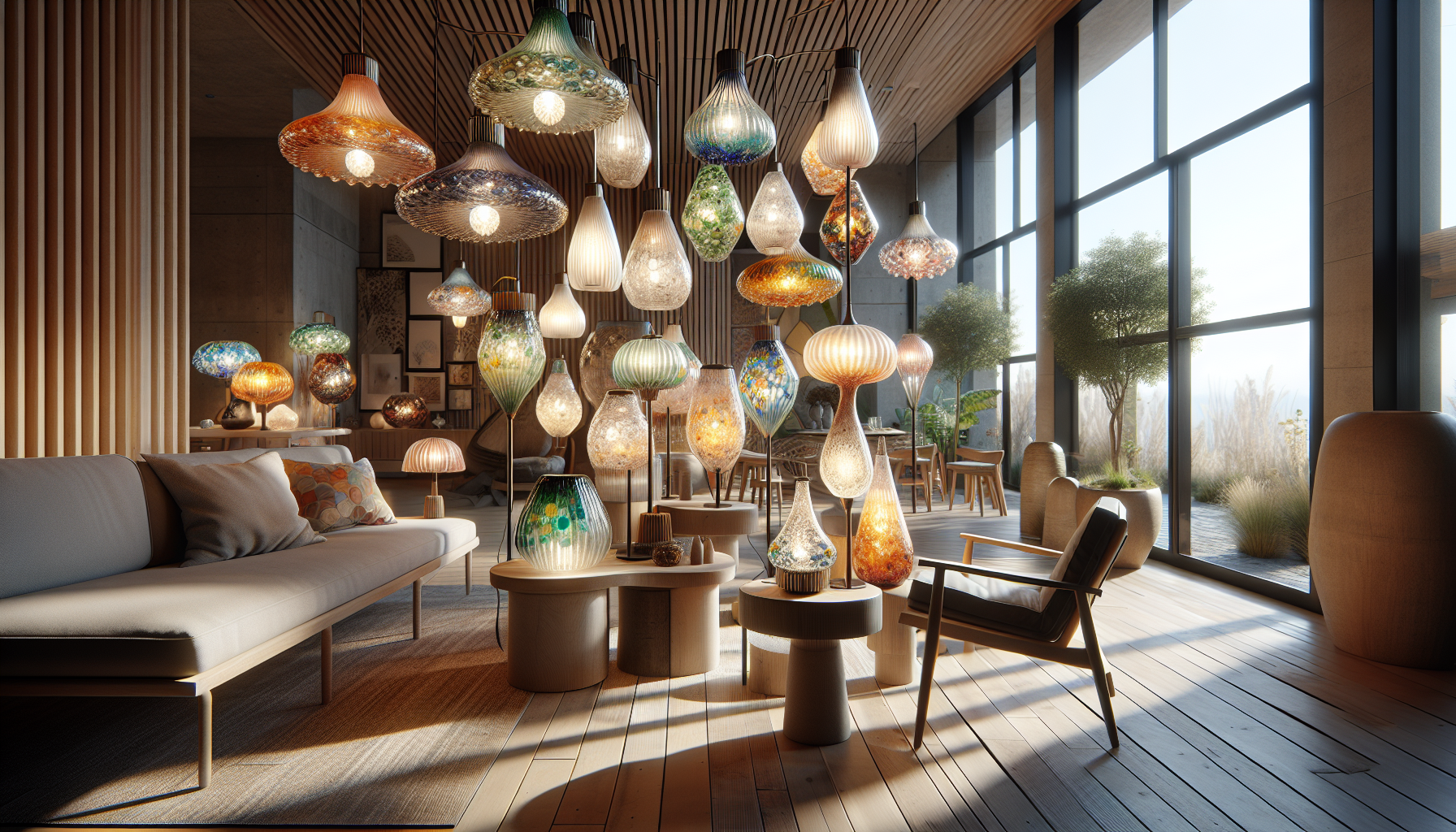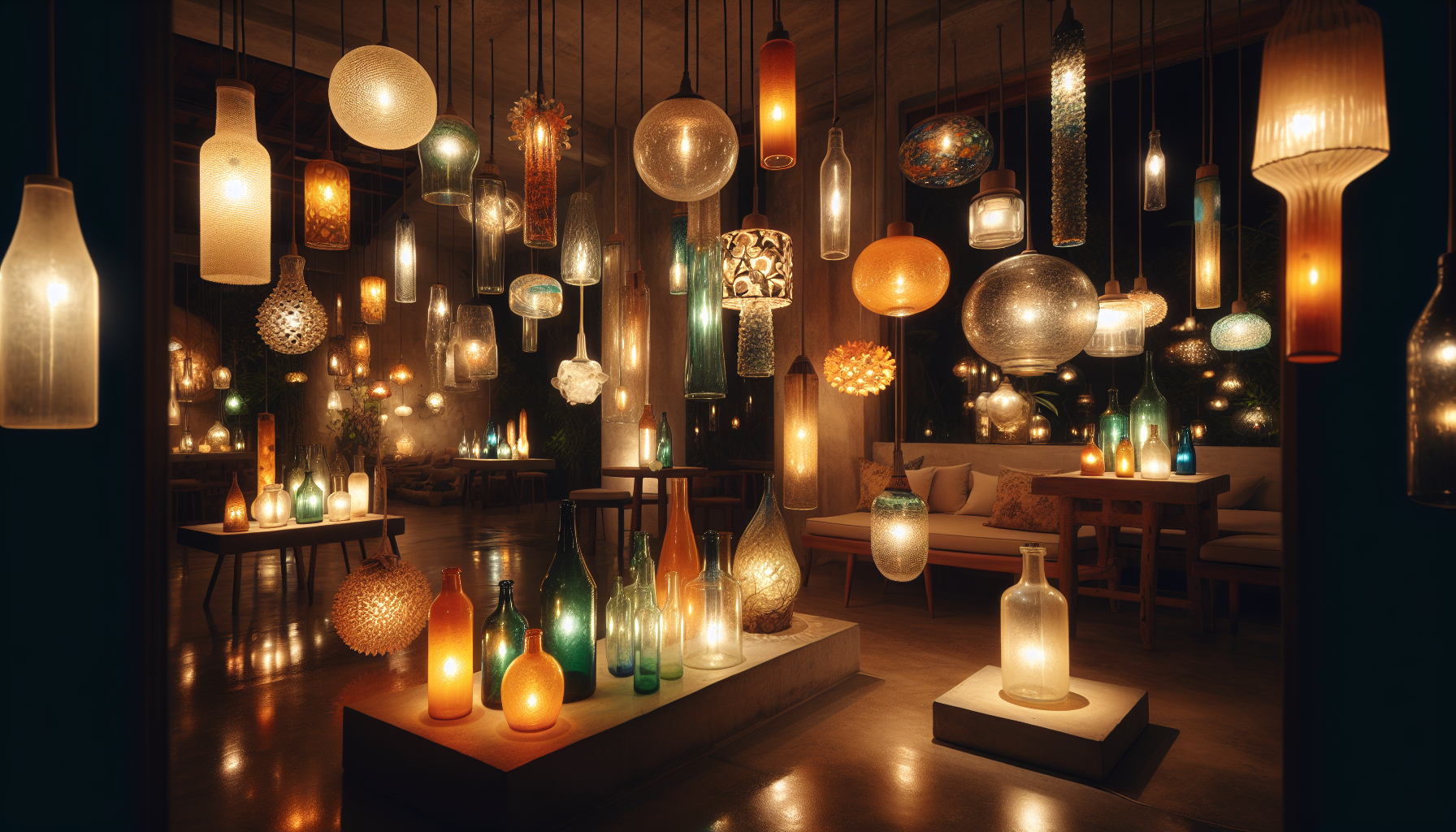In an era where sustainability is not just a choice but a necessity, the beauty of eco-friendly design has emerged as a beacon of hope and innovation. Our homes, often reflections of our personal ethos, have become canvases where art meets consciousness, and functionality harmonizes with responsibility. Imagine transforming an ordinary living space into an extraordinary gallery of light and form, where every flicker of illumination tells a story of redemption and creativity. This is the enchanting world of handcrafted glass sculptural lamps made from recycled bottles—a testament to the potential of waste reborn into breathtaking elegance. These masterpieces do not merely light up a room; they kindle a movement towards a more mindful and aesthetically pleasing existence. ✨
In this exploration, we will delve into the fascinating process of how discarded glass bottles, once seen as mere refuse, are meticulously transformed into stunning works of art that illuminate spaces with an air of sophistication and environmental stewardship. We’ll uncover the artistry and craftsmanship involved in each piece, shedding light on the intricate techniques that marry age-old glassblowing traditions with modern sustainable practices. Through this journey, we will meet the visionary artisans who pour their passion and skill into every creation, breathing new life into materials that would otherwise be relegated to the shadows of a landfill.
But this article isn’t just about the artistic process; it’s a clarion call to embrace the power of conscious consumerism. We will discuss the broader implications of integrating eco-friendly elegance into our everyday lives, examining how these sculptural lamps serve as poignant symbols of a commitment to preserving our planet without compromising on beauty or style. Whether you’re an interior design aficionado, a sustainability advocate, or someone simply looking to add a touch of uniqueness to your living space, this exploration promises to illuminate the path towards a future where every choice we make is a testament to our love for the world we inhabit. Join us as we unravel the magic that lies at the intersection of art, light, and sustainability, and discover how you can be a part of this luminous journey.
The Art of Upcycling: Transforming Recycled Bottles into Beautiful Sculptural Lamps
In the age of environmental consciousness, upcycling has emerged as a pivotal practice in reducing waste and promoting sustainability. The process of upcycling involves transforming waste materials into new products of better quality or higher environmental value. Among the various materials that can be upcycled, glass bottles stand out as a versatile and abundant resource. Handcrafted glass sculptural lamps from recycled bottles not only illuminate spaces with their eco-friendly elegance but also add an artistic flair that speaks to both environmental awareness and aesthetic appreciation.
Glass bottles, often seen as mere disposable items, can be transformed into stunning works of art through the careful and creative process of upcycling. The crafting of glass sculptural lamps involves a meticulous approach where each bottle is handpicked, cut, and shaped to form unique and eye-catching designs. This process not only saves bottles from ending up in landfills but also allows artisans to express their creativity and craftsmanship, resulting in one-of-a-kind pieces that light up rooms in more ways than one.
These lamps offer a unique blend of functionality and artistic expression. They serve the primary purpose of providing light while also acting as a statement piece that can complement any interior design style. Whether it’s a modern, minimalist room or a cozy, rustic setting, a handcrafted glass lamp from recycled bottles can enhance the ambiance with its charming glow and artistic silhouette. Moreover, choosing such eco-friendly lighting solutions aligns with the growing trend of sustainable living, allowing consumers to make environmentally conscious decisions without compromising on style or quality.
Understanding the Upcycling Process
The journey of transforming recycled bottles into sculptural lamps begins with the selection of suitable glass containers. These bottles, often collected from local communities or recycling centers, are chosen for their unique shapes, colors, and sizes. Once selected, the bottles undergo a thorough cleaning process to ensure they are free from labels and residues. This step is crucial as it prepares the glass for further manipulation and enhances the clarity and brilliance of the final product.
After cleaning, the next step involves cutting and reshaping the bottles. This stage requires precision and skill, as the glass must be cut without cracking or shattering. Artisans use specialized tools and techniques to carefully slice the glass, often employing methods such as water-jet cutting or glass scoring. These techniques allow for clean, precise cuts that form the basis of the lamp’s structure.
Once the bottles are cut, they are shaped and assembled into the desired lamp design. This stage is where the artisan’s creativity truly shines, as they arrange the glass pieces to create unique patterns and structures. The use of different bottle colors and shapes adds depth and dimension to the lamp, resulting in a stunning visual effect when illuminated. The final step involves fitting the lamp with electrical components, ensuring it is both functional and safe for everyday use.
The Environmental Impact of Upcycled Glass Lamps
Choosing upcycled glass lamps over conventional lighting options has significant environmental benefits. By repurposing glass bottles, these lamps reduce the demand for new raw materials and minimize the energy consumption associated with the production of new glass products. This reduction in resource usage contributes to a decrease in carbon emissions, making upcycled glass lamps a greener alternative for environmentally conscious consumers.
Moreover, the process of upcycling helps to divert glass waste from landfills. Glass, while recyclable, is often discarded due to the lack of facilities equipped to process it. By turning these discarded bottles into functional art, upcycling not only reduces waste but also extends the life cycle of the material, promoting a circular economy.
Additionally, the production of handcrafted glass lamps supports local artisans and small businesses. These creators often rely on sustainable practices and prioritize quality over mass production. By choosing upcycled glass lamps, consumers support these small-scale operations, which are vital to fostering sustainable economic growth and preserving traditional craftsmanship.
Comparing Upcycled Glass Lamps to Conventional Lighting
When considering lighting options, it’s essential to weigh the benefits of upcycled glass lamps against conventional alternatives. The table below provides a comparative analysis highlighting key aspects such as environmental impact, cost, and aesthetic value:
| Aspect | Upcycled Glass Lamps | Conventional Lighting |
|---|---|---|
| Environmental Impact | Reduces waste, promotes recycling, lower carbon footprint | Higher resource consumption, greater carbon emissions |
| Cost | Variable, often supports local artisans | Generally lower, mass-produced |
| Aesthetic Value | Unique, artistic, customizable | Standardized, limited design options |
| Durability | High, due to quality craftsmanship | Varies, often depends on brand |
As illustrated in the table, upcycled glass lamps offer distinct advantages in terms of environmental sustainability and aesthetic appeal. While they may come at a higher initial cost, their unique designs and contribution to eco-friendly practices provide added value that often outweighs the price difference.
The Artistic Expression of Glass Lamps
The artistry involved in crafting upcycled glass lamps extends beyond mere functionality. Each piece is a testament to the creativity and skill of the artisan, reflecting a blend of tradition and innovation. These lamps can be seen as sculptures in their own right, serving as focal points in interior spaces and sparking conversations about art and sustainability.
The diversity in design is vast, with artisans experimenting with different styles, colors, and patterns. Some lamps feature intricate, geometric designs, while others boast organic, fluid shapes that mimic natural forms. This variety ensures that there is an upcycled glass lamp to suit every taste and interior design preference.
For those interested in seeing the creative process in action, the video “How to Make a Lamp from Recycled Glass Bottles” by Green World on YouTube offers an insightful glimpse into the craft. Watch the video below to learn more about the techniques and artistry involved in creating these stunning pieces:
How to Make a Lamp from Recycled Glass Bottles – Green World
Integrating Upcycled Lamps into Your Space
Integrating upcycled glass lamps into your living space is a straightforward process that can transform the ambiance of a room. Here are some tips for incorporating these unique pieces into your home decor:
- Consider the lamp’s style and how it complements your existing decor. Whether you prefer a modern, minimalist look or a more eclectic, bohemian vibe, there’s an upcycled glass lamp that can fit seamlessly into your design scheme.
- Use the lamp as a focal point in a room. Place it on a prominent surface such as a console table, side table, or even as a centerpiece on a dining table to draw attention to its artistic design.
- Experiment with lighting placement. Upcycled glass lamps can create beautiful lighting effects when positioned near mirrors or reflective surfaces, enhancing the overall aesthetic of the space.
By thoughtfully incorporating upcycled glass lamps into your home, you not only enhance the visual appeal of your space but also make a conscious choice towards sustainability and environmental responsibility.

Conclusion
In conclusion, the exploration of eco-friendly elegance through handcrafted glass sculptural lamps made from recycled bottles brings to light a transformative approach to both design and sustainability. This article delved into the intricate artistry involved in creating these unique pieces, underscoring the significance of recycling and repurposing in modern interior design. By choosing to illuminate our spaces with such creative and environmentally-conscious alternatives, we not only contribute to the reduction of waste but also embrace a style that is both sophisticated and sustainable.
The main points covered in the article emphasized the environmental impact of glass waste and the potential for artistic innovation in its reuse. Glass bottles, often discarded and forgotten, become a canvas for skilled artisans who transform them into stunning sculptural lamps. This process not only mitigates the negative effects of waste on our planet but also gives rise to a new form of art that combines functionality with aesthetic appeal.
Additionally, the article highlighted the meticulous craftsmanship involved in the creation of these lamps. Each piece is a testament to the dedication and skill of artisans who breathe new life into recycled materials. The lamps are not merely lighting fixtures; they are statement pieces that add character and charm to any space, while also telling a story of sustainability and creativity.
The importance of this topic extends beyond the realm of interior design. It touches on broader themes of environmental responsibility and conscious consumerism. By opting for products that align with these values, we contribute to a larger movement towards a more sustainable future. The choices we make in our homes can have a profound impact on the world, encouraging industries to innovate and prioritize eco-friendly practices.
Furthermore, the handcrafted nature of these lamps fosters a connection between the consumer and the creator. In a world increasingly dominated by mass production, there is something inherently special about owning a piece that has been carefully crafted by human hands. This connection not only enhances the value of the product but also reinforces the importance of supporting local artisans and sustainable practices.
As you consider the information and insights presented in this article, I encourage you to reflect on the impact of your own consumption habits. Consider the ways in which you can integrate sustainable practices into your daily life, whether through the purchase of eco-friendly products or by supporting local artisans and businesses that prioritize environmental responsibility.
Engaging with this topic is not just about making informed choices; it’s about inspiring others to do the same. Share the knowledge and insights you’ve gained with friends and family, sparking conversations about the importance of sustainability and the role we each play in preserving our planet. Every small action counts, and by working together, we can create a ripple effect that leads to meaningful change.
If you’re intrigued by the idea of incorporating handcrafted glass sculptural lamps into your living space, consider exploring local artisans and businesses that specialize in sustainable designs. By doing so, you not only acquire a unique and beautiful piece for your home but also support a network of creators who are committed to environmentally-friendly practices.
To further explore the themes discussed in this article, I recommend delving into resources that focus on sustainable design and innovation. Websites such as Earth911 and Sustainable Furnishings Council offer valuable insights into eco-friendly practices and products. These platforms provide a wealth of information for those interested in making more sustainable choices in their daily lives.
In conclusion, let this article serve as a reminder of the power of creativity and innovation in addressing environmental challenges. Handcrafted glass sculptural lamps from recycled bottles are not just a trend; they are a testament to the enduring potential of sustainable design. By embracing these practices, we illuminate not only our homes but also the path towards a more sustainable and elegant future. ✨
Join the conversation by sharing your thoughts in the comments section. How do you plan to incorporate sustainable practices into your home? Have you come across any unique eco-friendly products that have inspired you? Let’s inspire each other to create beautiful, sustainable spaces that reflect our commitment to the planet. Together, we can make a difference, one elegant design at a time. 🌍
Toni Santos is a lighting artisan and visual explorer who designs atmospheres, not just objects. With a refined sensitivity to form, reflection, and emotion, Toni’s work at Sordux is an ode to how light transforms space, feeling, and story.
Through his handcrafted creations — from artistic glass bottles to radiant lighting totems — Toni invites us to see light as more than function. To him, light is symbolic. It is memory, energy, and meaning in motion.
Drawing inspiration from modern minimalism, ancestral aesthetics, and organic shapes, Toni blends natural materials with ambient expression. His collections are not just decorative — they’re immersive experiences, each one crafted to awaken the senses and reconnect us to the spaces we inhabit.
As the mind behind Sordux, Toni curates a world where illumination becomes ritual, and where every design element — from the curvature of a bottle to the hue of a glow — speaks of intention and presence.
🔥 His vision shines through:
-
Designs that merge mood with form
-
Bottled light as symbolic storytelling
-
Sustainable aesthetics rooted in artistic function
Whether you’re a designer, a dreamer, or someone who understands that light is a language of its own, Toni invites you into a world where glow becomes meaning, and every beam is an invitation to feel.





